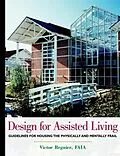Destined to become the defining work on the subject, this timely reference addresses the single fastest growing segment of the senior living industry -- assisted living for those who are unable to live independently but who do not need intensive nursing home care, meals, housekeeping, or twenty-four hour access to medical assistance. Victor Regnier's visually rich guide includes dozens of design solutions from successful assisted living facilities along with fifteen case studies from the U.S. and Europe. The book also covers recent developments in the industry including major changes in financing, growth of dementia, and interest in aging-in-place. All in all, this is the most comprehensive guide to assisted living design that you'll find in any single volume.
Autorentext
Victor Regnier, FAIA, is an architect, gerontologist, and one of the world's leading authorities on the design of housing for older people. He holds a professorship between the USC School of Architecture and the Leonard Davis School of Gerontology. A former European Fulbright Scholar, his research and design efforts have garnered awards from the American Society of Landscape Architects, Progressive Architecture, and the Gerontological Society. The author of five books and research monographs, he has also consulted on over 250 building projects in twenty-eight states, Canada, England, and Germany.
Klappentext
"Victor Regnier has produced another excellent and useful book that chronicles the last ten years of progress in assisted living design. From design considerations to case studies using hundreds of photographs and illustrations, the book communicates dozens of cutting-edge concepts."
-David J. Hoglund, FAIA, Partner, Perkins-Eastman Architects
Spurred by increases in the oldest-old population, long-term care has been reinvented in the form of attractive, homelike settings. Design for Assisted Living provides solutions to the challenges of creating these environments now and into the future. This visually rich book gives a complete overview of designing for the mentally and physically frail elderly. Research garnered from hundreds of buildings in the United States and northern Europe is presented here in design directives, case studies, and practical guidelines.
This comprehensive reference includes:
* Specific solutions: 100 qualities and characteristics of successful environments-such as ways to make larger rooms appear smaller-circulation patterns that lead to greater social interaction, and new approaches to "edge spaces" like porches and winter gardens
* Recent developments: designs that promote exercise therapy, therapeutic designs for dementia, and environmental and service changes that support "aging in place"
* Key issues: site design, therapeutic garden design, interior design specifications, lighting treatments, unit design features, and regulatory impediments
* Resources: photographs from dozens of the best-designed facilities in the United States and Europe along with floor plans from fifteen outstanding case studies
Complete with management tips, future predictions and trends, benchmarking statistics, and lessons learned from Europe, Design for Assisted Living is an indispensable resource for architects, planners, interior designers, landscape architects, and housing providers, as well as gerontologists, nursing home administrators, housing managers, and policymakers.
Inhalt
Acknowledgments.
Preface.
PART I: ASSISTED LIVING DEFINED.
What is Assisted Living?
Benchmarking Assisted Living Buildings and Residents.
Defining Conceptual Frameworks for Assisted Living Environments and Services.
PART II: ONE HUNDRED CRITICAL DESIGN CONSIDERATIONS.
Neighborhood and Site Issues.
The Outdoor Landscape.
Refining Design Attributes.
Stimulating Social Interaction.
Extending Independence.
Stimulating the Senses.
Creating Affect.
Planning the Dwelling Unit.
Engaging the Staff.
Designing for Dementia.
PART III: CASE STUDIES.
Humanitas Bergweg, Rotterdam, The Netherlands.
Wilhelmiina, Helsinki, Finland.
Goddard House, Brookline, MA.
Gyngemosegard, Herlev, Denmark.
Sunrise of Mission Viejo, CA.
Sunrise of Bellevue, WA.
Crown Cove, Corona Del Mar, CA.
Sunrise of Richmond, VA.
Copper Ridge, Sykesville, MD.
Virranranta, Kiruvesi, Finland.
Harbor House, Greendale, WI.
Ros Anders Gard, Vesterhaninge, Sweden.
Humlehusene, Albertslund, Denmark.
Postiljonen. Holliviken, Sweden.
Metsatahti, Hankasalmi, Finland.
PART IV: CONCLUSIONS AND DIRECTIVES.
Lessons Learned from Northern European Visits.
Other Lessons from Each Individual Country.
Twenty Most Important Design Issues and Considerations.
Thirty Future Trends.
Concluding Issues.
Appendix A: Noteworthy Buildings.
Appendix B: Additional Important Buildings.
Appendix C: Glossary of Housing Terms.
References.
Index.
